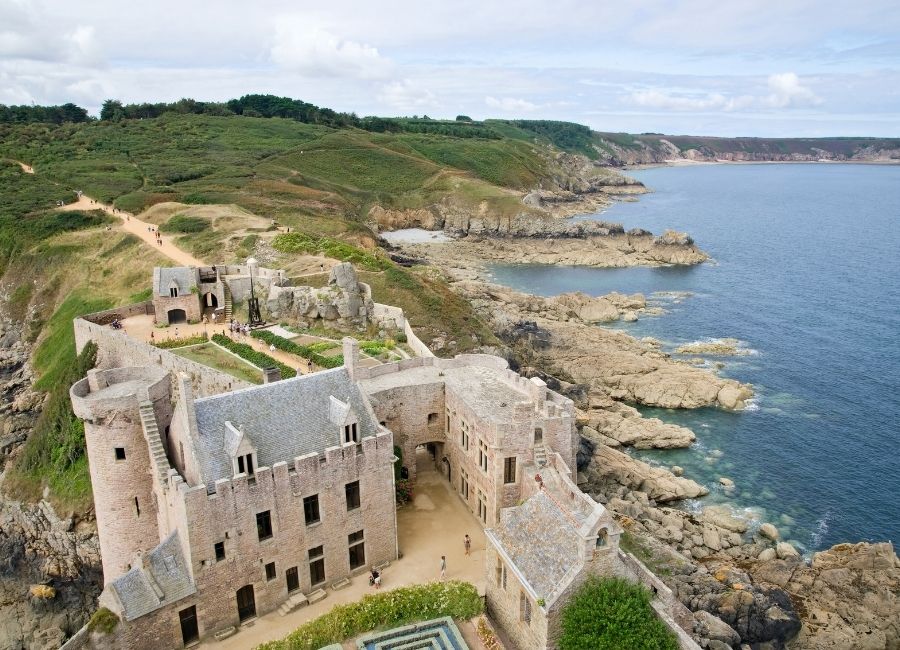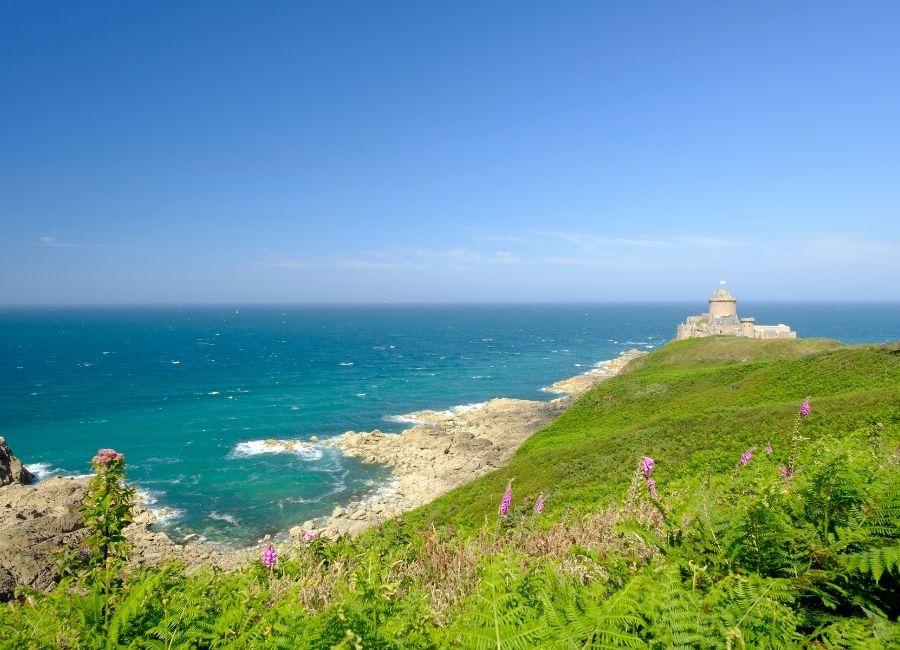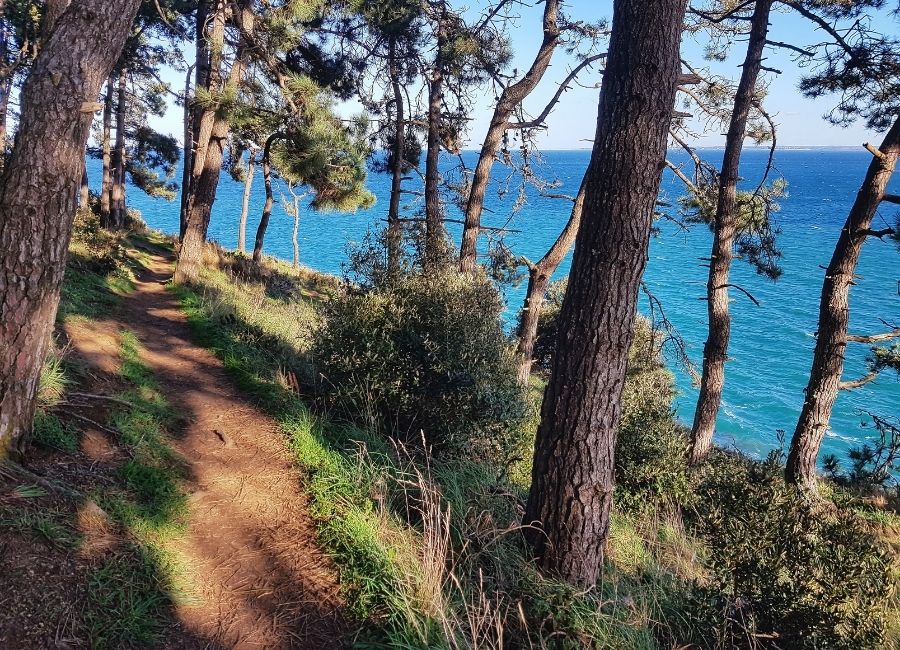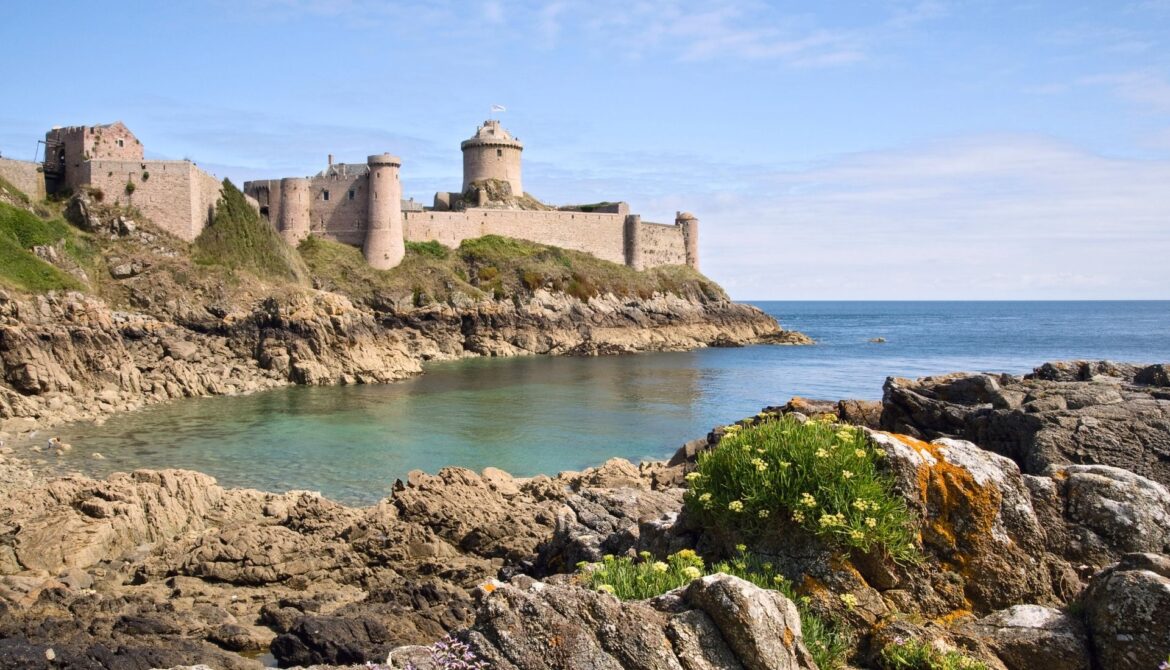Perched dramatically on the jagged cliffs of Brittany’s Emerald Coast, Fort la Latte—formally known as Château de la Roche Goyon—has endured nearly 700 years of warfare, abandonment, revival, and cinematic fame. With sweeping views over the English Channel and a defensive posture that once terrified invaders, this castle has evolved from a medieval stronghold to a Vauban-style fort and, today, one of France’s most visited privately owned monuments.
Medieval Origins: The Goyon Legacy

Fort la Latte traces its earliest form to circa 937, when a simple wooden structure likely existed on the site. The present-day stone fortress began construction in the 1340s, commissioned by Étienne III Goyon, Lord of Matignon. As part of the powerful Goyon family lineage, he sought to fortify his dominion against the instability of 14th-century feudal wars.
The castle’s central keep, completed by around 1370, was emblematic of feudal power, designed with machicolations, arrow slits, and a commanding view of the Channel to deter piracy and seaborne raids.
Fort la Latte Bookable Guided Tours and Surrounding Experiences
War and Ruin: From Succession Battles to Religious Conflicts
The Breton War of Succession brought Fort la Latte into the crosshairs. In 1379, it was besieged and seized by the famed French knight Bertrand du Guesclin, though it was returned to Goyon hands under the Treaty of Guérande (1381).
The fortress withstood further military pressure during the Wars of Religion, but in 1597 it was ultimately overrun, looted, and burned by Protestant forces. Only the imposing donjon survived relatively intact.
Coastal Fortification: The Vauban Influence
Abandoned for decades, Fort la Latte returned to prominence during the reign of Louis XIV. Under the guidance of engineer Siméon Garangeau, a disciple of Vauban, the fortress underwent a significant transformation between 1690 and 1715. New ramparts, gun platforms, and bastions were installed to modernize the fort for gunpowder warfare.
A notable addition was a furnace for heating cannonballs (“boulets rouges”), used to ignite wooden ships and a rare feature preserved today.
Revolutionary France and Decline
During the French Revolution, Fort la Latte briefly resumed military importance. In 1793, its heated shot furnace became operational. The fort again saw conflict during Napoleon’s Hundred Days (1815) but was decommissioned shortly thereafter as evolving military technology rendered it obsolete. In 1892, the French government sold the structure to private owners.
Restoration and Cultural Revival
In 1931, historian Frédéric Joüon des Longrais purchased the dilapidated site and began a decades-long restoration. By 1950, he had reestablished much of its medieval character, and in 1925 (prior to his purchase), the site was designated a Monument Historique by the French Ministry of Culture.
Remarkably, Fort la Latte was not connected to electricity until 2001, a fact that underscores its remote, resilient character.
A Stage for Legend and Cinema

Fort la Latte’s cinematic silhouette has captured the imagination of directors and viewers alike. It starred in films such as The Vikings (1958) with Kirk Douglas and Tony Curtis, The Three Musketeers (1948), and Chouans! (1987). More recently, it appeared in music videos and animations like April and the Extraordinary World (2015).
Each August, the site hosts Les Grandes Médiévales, a multi-day medieval festival featuring reenactments, falconry, artisan markets, and jousting tournaments. These festivities attract thousands of visitors, solidifying its role as both a cultural and historical landmark.
Architectural Highlights
Visitors today encounter a fortress separated from the mainland by a dramatic chasm, accessible only by drawbridge. Key features include:
- Two drawbridges and gatehouses
- 13th-century chapel and governor’s house
- Medieval garden with medicinal and culinary herbs
- Machicolated donjon with stone carvings representing the four Evangelists
- Cistern and granaries for long-term siege survival
- 18th-century furnace for heated cannonballs
This seamless integration of medieval and early modern fortification elements makes Fort la Latte one of the most visually and structurally impressive castles in France.
Key Historical Milestones at a Glance
| Period | Event |
|---|---|
| ~937 | Early wood-and-earth fortress possibly built by the Goyon family |
| 1340s–1370 | Stone castle construction under Étienne III Goyon, including the donjon |
| 1379 | Besieged and captured by Bertrand du Guesclin |
| 1381 | Returned to Goyon ownership under Treaty of Guérande |
| 1597 | Sacked during the Wars of Religion; largely destroyed |
| 1690–1715 | Vauban-style refortification by Siméon Garangeau under Louis XIV |
| 1793 | Revolutionary furnace added for heating cannonballs |
| 1815 | Attempted storming during Napoleon’s Hundred Days |
| 1892 | Sold by the state to private ownership |
| 1925 | Classified as a French Monument Historique |
| 1931–1950s | Restoration by Frédéric Joüon des Longrais |
| 2001 | Castle electrified for the first time |
Planning Your Visit: How to Experience Fort la Latte
Visiting Fort la Latte offers more than a history lesson—it’s an unforgettable experience on the Brittany coast. Here’s what you need to know to plan your trip:

🗺️ Location
- Region: Côtes-d’Armor, Brittany, France
- Nearest Town: Plévenon
- GPS: 48.6518° N, 2.2947° W
- Nearby Landmark: Cap Fréhel (2 km by coastal path)
🛫 Nearest Airports
- Dinard–Pleurtuit–Saint-Malo Airport (DNR): ~45 min by car (35 km)
- Rennes–Saint-Jacques Airport (RNS): ~1 hr 45 min (110 km)
- Nantes Atlantique Airport (NTE): ~3 hrs (210 km)
🚗 Getting There
- By Car: The easiest and most flexible option. Free parking is available on-site.
- By Train: Take a TGV to Saint-Malo or Lamballe, then rent a car for the final leg.
- By Bike or Hike: Popular coastal trails connect Cap Fréhel and Fort la Latte, offering breathtaking sea views.
⏰ Opening Hours (Seasonal)
- Spring to Autumn (April–October): Daily, usually 10am–6pm (check website)
- Winter Months: Limited hours or closed; check ahead
- Website: lefortlalatte.com
🎟️ Ticket Prices
- Adults: ~€7.50
- Children: ~€5.00 (under 5 free)
- Group and family discounts available
🏰 Best Time to Visit
- Late spring through early autumn offers pleasant weather and active event programming
- The Grandes Médiévales festival in August is a must-see for immersive medieval experiences
Fort la Latte embodies the turbulent history of Brittany and the architectural evolution of coastal defense in France. Its survival through sieges, religious conflict, revolution, and neglect is a testament to its strategic importance and cultural significance. Whether you’re drawn by its sweeping vistas, cinematic pedigree, or historical depth, a visit to Fort la Latte offers a journey through time along one of France’s most storied coastlines.
Frequently Asked Questions About the History of Fort la Latte and How to Visit
Yes. Whether you’re interested in history, military architecture, or cinematic backdrops, Fort la Latte offers a rich and scenic experience that’s both educational and awe-inspiring.
Fort la Latte is located in Plévenon, in the Côtes-d’Armor department of Brittany, France. It’s perched on a rocky cliff overlooking the English Channel and is about 2 km from Cap Fréhel.
Take the TGV from Paris to Saint-Malo or Lamballe (around 2.5–3 hours), then rent a car for the scenic 45–60 minute drive to Fort la Latte. There are no direct buses to the site.
Yes! There’s a popular coastal path that links Cap Fréhel to Fort la Latte. The trail offers exceptional sea views and takes about 30–40 minutes on foot. Bicycles are also welcome, with racks near the entrance.
Most visitors spend 1.5 to 2 hours exploring the grounds, castle interior, gardens, and enjoying the sea views. Longer if attending a festival or guided tour.
Absolutely. Children enjoy the drawbridges, towers, and medieval reenactments during festival days. The site is stroller-accessible in many areas, though some sections have steep stairs.
Dogs are permitted on a leash in outdoor areas but not inside the castle buildings.
Photography is allowed for personal use, but drones are generally prohibited unless you have advance written permission from the property’s owners due to preservation laws.
Cap Fréhel, with its striking lighthouse and heather-covered cliffs, is just a short walk away. Also consider visiting the charming port town of Saint-Cast-le-Guildo or the fortified town of Dinan.
Les Grandes Médiévales typically takes place over a weekend in August. It features costumed reenactors, jousting, medieval crafts, and live performances. Tickets sell out quickly.
Opening hours are reduced in winter and the site may close during severe weather. Always check the official website before planning an off-season visit.
Yes, guided tours are available in English, especially during the high season. It’s recommended to reserve in advance for groups or during festival periods.
Some areas, including the garden and lower courtyards, are accessible. However, upper levels, towers, and narrow staircases may be challenging. Contact the site in advance for specific accessibility accommodations.
